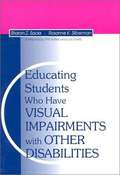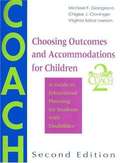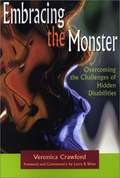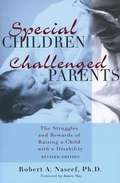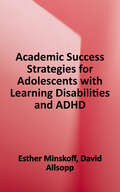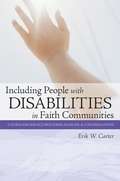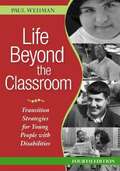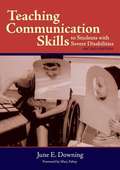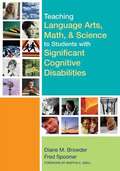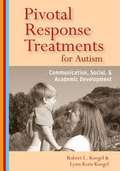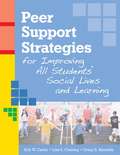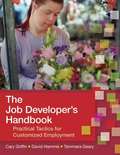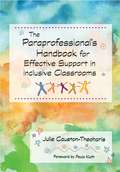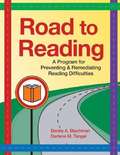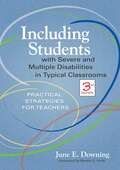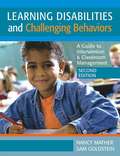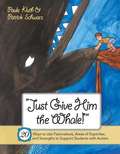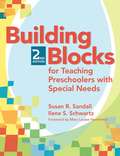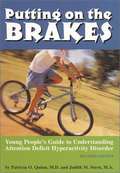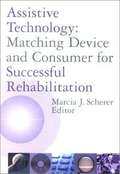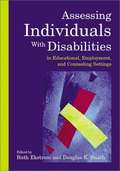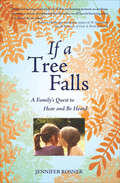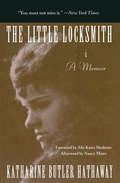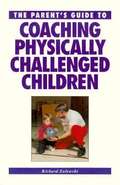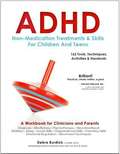- Table View
- List View
Educating Students Who Have Visual Impairments With Other Disabilities
by Sharon Sacks Rosanne K. SilbermanWith a concentration on education needs, learning styles, and recommended classroom practices, this introductory text demonstrates functional assessment and teaching adaptations that improve inclusive learning experiences for students with a wide range of visual impairments and multiple disabilities.
Choosing Outcomes and Accommodations for Children: A Guide to Educational Planning for Students with Disabilities (2nd edition)
by Michael F. Giangreco Chigee J. Cloninger Virginia S. IversonRevised in response to research and user feedback, COACH offers you redesigned forms, more explicit instructions, and helpful hints, and tabs and icons so you can easily locate information.
Embracing the Monster: Overcoming the Challenges of Hidden Disabilities
by Veronica CrawfordWhat is it like to live with disabilities no one can see? Readers will find out in this honest and gripping narrative of one woman's life with hidden disabilities--including learning disabilities, ADHD, and bipolar disorder. Yet this is more than just her story of battling adversity and coming out a winner.
Special Children, Challenged Parents: The Struggles and Rewards of Raising a Child with a Disability
by Robert NaseefRaising children with special health care or developmental needs is uniquely so. At times, the challenges seem overwhelming and even oppressive.
Academic Success Strategies for Adolescents with Learning Disabilities and ADHD
by David Allsopp Esther MinskoffWith this strategy-filled handbook, education professionals will learn what they can do to help students with mild disabilities—from high school to post-high school—develop academic skills in: organization, test-taking, study skills, note taking, reading, writing, and math. <p><p> First, educators will work one-on-one with students to evaluate each student's learning style and individual needs. Then, for each of the areas listed above, educators will get a chapter with step-by-step cognitive learning strategies, case studies, and charts that summarize the steps as mnemonic devices. An overarching five-step model (the Active Learner Approach) for effective instruction helps teachers introduce these strategies to students, model the steps of the strategies for them, give students guided and independent practice applying the strategies to assignments, and assist students in generalizing the strategies to other subjects and settings. <p><p>With this easy-to-use guide, educators will be able to help students recognize their learning characteristics, apply strategies to meet the specific demands of their coursework independently, and reach their educational goals.
Including People With Disabilities in Faith Communities: A Guide for Service Providers, Families, and Congregations
by Erik W. CarterA congregational community is an ideal place to share and strengthen faith, form lasting relationships, and develop special gifts and talents. Too often, though, people with developmental and other disabilities lack the opportunities and supports to fully participate in the life of their faith community. That's why families and service providers need to read this groundbreaking guidebook--and share a copy with congregations that want to become places of welcome and belonging for people with disabilities. Bringing his practical ideas to life with anecdotes, quotes, and examples of successful strategies, Erik Carter helps readers reflect on how welcoming their congregation is--and could be--for people with disabilities and their families articulate and pursue a bold vision of inclusion throughout their congregation, community, city, or state take steps to break down attitudinal, architectural, programmatic, and other barriers to inclusion design appropriate, inclusive religious education programs for children, youth, and adults learn how service providers can actively support the spiritual preferences, strengths, and needs of people with disabilities To make inclusion work in any faith community, this how-to book gives readers workable strategies and photocopiable forms for identifying indicators of welcome; encouraging community outreach, and gathering important information about the support needs of people with disabilities and their families.
Life Beyond the Classroom: Transition Strategies for Young People with Disabilities
by Paul WehmanThis classic text, adopted by educators in special and vocational education programs across the country, provides a framework for defining and planning transition, addresses facilitation and support, and discusses ways to individualize transition service delivery for people with specific types of disabilities. Instructors in special and vocational education, and rehabilitation programs love how this text blends theory with practical forms, sample individualized transition plans, and helpful study questions. Photocopiable charts and checklists make it great for the field, as well, so their students will benefit from this text beyond the classroom. The fourth edition is updated with new material on self-determination, inclusion (in schools and the community), high stakes accountability, assistive technology, job carving, social security benefits issues, and application for youth with autism spectrum disorders.
Teaching Communication Skills to Students with Severe Disabilities
by June E. DowningLearners with severe disabilities frequently encounter two problems: they have difficulty in the classroom giving and receiving responses appropriate to their needs, and they are confronted by instructors and aides whose insufficient expertise and discomfort causes negative classroom experiences for all involved. Writing for both in-service and pre-service teachers, Downing (special education, California State U., Northridge) provides strategies they can use to develop confidence in their skills as assessors of communication skills and needs and providers of instruction geared toward the needs of learners. She and her contributors give systematic advice about preparing a good learning environment, teaching in an inclusive classroom, meeting students where they are in their communication, and working in teams to bridge gaps in knowledge and experience. Annotation ©2005 Book News, Inc., Portland, OR (booknews.com)
Teaching Language Arts, Math, and Science to Students With Significant Cognitive Disabilities
by Diane M. Browder Fred SpoonerUnder NCLB, students with severe disabilities are expected to make progress on state academic content standards in language arts, math, and science. But what material should educators teach from these three content areas, and how should they teach it? With this groundbreaking textbook, future educators will have the answers they need. The first major research-to-practice resource on this critical topic, this text goes beyond functional and access skills and shows educators how to make the general curriculum accessible to students of all ages with significant cognitive disabilities. Twenty-five of the best-known researchers in the field prepare educators to - adapt lessons in language arts, math, and science for students with disabilities - identify meaningful instructional content - create effective learning environments through instructional procedures such as peer tutoring, cooperative learning, and co-teaching - set appropriate expectations for student achievement - align instruction with state content standards and alternate assessment For each content area, future teachers will get a solid research foundation blended with teaching examples, guidelines, and helpful figures and tables. A timely textbook for pre-service educators--and a valuable reference for in-service teachers seeking guidance--this important resource will raise expectations for students with disabilities and ensure their progress in key academic areas. Learn how to teach - Language Arts. Move beyond sight-word recognition and teach the literacy components identified by the National Reading Panel - Math. Help students learn higher-level math concepts such as problem solving, reasoning, connections, and representations, as well as functional skills - Science.
Pivotal Response Treatment For Autism: Communication, Social, And Academic Development
by Lynn Kern Koegel Robert L. KoegelDiscover how to use natural learning opportunities to target and modify key behaviors in children with autism, leading to widespread positive effects on communication, behavior, and social skills. It's all possible with the innovative, widely used Pivotal Response Treatment (PRT), an empirically supported treatment for autism recognized by the National Professional Development Center on Autism Spectrum Disorders and the National Standards Project. <p><p> Because PRT works with each child's natural motivations and stresses functional communication over rote learning, this comprehensive model helps children develop skills they can really use. With this timely resource, educators and therapists will support children with autism as they enjoy more positive interactions, more effective communication, and higher academic achievement in natural, inclusive settings.
Peer Support Strategies For Improving All Students' Social Lives And Learning
by Erik W. Carter Craig H. Kennedy Lisa S. CushingPeer supports really work: they're a great, efficient way to help all students learn, make the most of teacher/ paraprofessional time, and increase the achievement level of challenging students. This is the concise, practical guide every middle and high school needs to implement peer support strategies--including cooperative learning and peer tutoring--to benefit students with moderate to severe disabilities and their peers. With this reader-friendly, step-by-step planning guide from the foremost authorities on peer supports, educators, paraprofessionals, and other school staff will discover how peer supports are a "two-way street," boosting the academic outcomes, social skills, and self-esteem of students with disabilities and the peers who support them determine which students might benefit most from peer supports recruit and match the students most likely to form mutually beneficial relationships develop effective support plans that promote access to the general curriculum work peer supports into IEP goals to meet state and national academic standards give students the training and guidance they need to approach their support roles with confidence and enthusiasm clarify the responsibilities of everyone involved in a peer support system: students, general and special educators, paraprofessionals and other school staff provide peers with constructive ongoing feedback extend peer supports to school activities and extracurricular events evaluate the social and academic impact of peer support arrangements A complete, start-to-finish guide to peer supports, this book is packed with photocopiable planning, implementation, and evaluation tools; evidence-based strategies; and vignettes that illustrate successful peer supports. With this must-have book on one of the hottest topics in inclusive education, educators and paraprofessionals will create schools where all students--with and without disabilities--help each other reach their academic goals, make new friends, and live full and meaningful lives.
The Job Developer's Handbook: Practical Tactics for Customized Employment
by Cary Griffin David Hammis Tammara Geary<p>One of the most practical employment books available, this forward-thinking guide walks employment specialists step by step through customized job development for people with disabilities, revealing the best ways to build a satisfying, meaningful job around a person's preferences, skills, and goals. Internationally known for their innovative, proactive job development strategies, the authors motivate readers to expand the way they think about employment opportunities and develop creative solutions. <p>Readers will get fresh, proven tips and ideas for every aspect of job development for youth and adults with significant support needs: <p> <li>discovering who the person is and what he or she really wants <li>ensuring goodness of fit between employer and employee <li>finding—or creating—"hidden jobs" in smaller companies <li>empowering people through resource ownership (investing in resources that employers need) <li>skillfully negotiating job duties while managing conflicts that might arise <li>creatively maximizing benefits using social security work incentives <li>encouraging family support while respecting the individual as an adult</li> <p> <p>To make each part of job development easier, the book arms readers with practical content they can really use: easy-to-follow, step-by-step guidelines; checklists of critical questions to answer; success stories in both urban and rural settings; and sample scenarios, dialogues, and interview questions. <p>Equally useful to veteran professionals and those just starting out, this compelling guidebook breathes new life into the job development process and helps readers imagine a wider world of employment opportunities for people with disabilities.</p>
The Paraprofessional's Handbook For Effective Support In Inclusive Classrooms
by Julie Causton-TheoharisWhat does a great paraprofessional need to know and do? Find out in this handy survival guide, equally useful for the brand-new paraprofessional or the 20-year classroom veteran. Packed with friendly guidance, practical tips, and relatable first-person stories, this book reveals the best ways to provide effective, respectful services to students in inclusive classrooms. Julie Causton-Theoharis, a teacher, professor, and educational consultant with more than 10 years of experience as a paraprofessional instructor, knows exactly how to help readers stop feeling overwhelmed so they can start making a difference. She answers all the urgent questions paraprofessionals have as they navigate their complex job in the inclusive classroom, showing readers how to: provide skillful and subtle support to students while encouraging their independence resolve challenging behavior in gentle and positive ways find students' strengths and match support practices to them fade their support make informed decisions about content-specific accommodations, modifications, and adaptations presume competence and keep expectations high facilitate peer supports and friendships partner with teachers, SLPs, psychologists, families, and other members of the educational team relieve their own stress and avoid burnout To help them master the daily ups and downs of the inclusive classroom, paraprofessionals will get ready-to-use practical content: tips for supporting students with specific disabilities, helpful question-and-answer sections, examples of successful problem-solving, a quick-guide to acronyms in education, easy ideas for improving teamwork, and more. The essential guide for every paraprofessional and a must-have for the educators and other professionals who support them this empowering book takes the guesswork out of a critical classroom role and helps students with disabilities reach their full potential.
Road to Reading: A Program for Preventing and Remediating Reading Difficulties
by Benita A. Blachman Darlene M. TangelRoad to Reading provides a framework for providing both early intervention to prevent reading difficulties and remedial instruction for students who are struggling to learn to read.
Including Students with Severe and Multiple Disabilities in Typical Classrooms: Practical Strategies for Teachers
by June E. Downing Martha E. SnellThe bestselling resource from the most trusted name in special education gets a top-to-bottom update in this new third edition. Revised to reflect the realities of today's K-12 classrooms, this book gives teachers all the latest research-based, practical strategies for fully including students with sensory impairments and cognitive and physical disabilities.
Learning Disabilities and Challenging Behaviors: A Guide to Intervention and Classroom Management (Second Edition)
by Sam Goldstein Nancy MatherTwo reasons educators want to implement this book's Building Blocks model in their classroom: They'll have an innovative framework to help them understand the reasons why students in K-12 struggle. They'll have the proven strategies to help students learn. The Building Blocks model is practical, supported by research, and easy to implement. It identifies ten areas important to school success (the building blocks), divided into three levels: the foundational level includes attention and impulse control, emotion and behavior, self-esteem, and learning environment blocks the symbolic processing and memory level contains the visual, auditory, and motor skills blocks the conceptual level comprises using strategies and thinking with language and images A detailed questionnaire for each block helps identify a student's strengths and limitations, cultivate their strengths, address the weaker areas, and develop appropriate accommodations and instructional interventions. Each chapter contains proven teacher strategies to give educators direct information to meet students' individual needs. Once educators understand the causes of students' classroom challenges, educators can design individualized and effective interventions.
Just Give Him the Whale!: 20 Ways to Use Fascinations, Areas of Expertise, and Strengths to Support Students with Autism
by Paula Kluth Patrick SchwarzWhen learners with autism have deep, consuming fascinations--trains, triangles, basketballs, whales--teachers often wonder what to do. This concise, highly practical guidebook gives educators across grade levels a powerful new way to think about students' "obsessions": as positive teaching tools that calm, motivate, and improve learning. Written by top autism experts and nationally renowned speakers Paula Kluth and Patrick Schwarz, this guide is brimming with easy tips and strategies for folding students' special interests, strengths, and areas of expertise into classroom lessons and routines. Teachers will discover how making the most of fascinations can help their students learn standards-based academic content boost literacy learning and mathematics skills develop social connections expand communication skills minimize anxiety and much more"Just Give Him the Whale" is packed from start to finish with unforgettable stories based on the authors' experience, firsthand perspectives from people with autism themselves, research-based recommendations that are easy to use right away, and sample forms teachers can adapt for use in their own classrooms. An enjoyable read with an eye-opening message, this short book will have a long-lasting impact on teachers' understanding of autism--and on their students' social and academic success.
Building Blocks For Teaching Preschoolers With Special Needs (Second Edition)
by Samuel L. Odom Susan R. Sandall Ilene S. Schwartz Gail E. Joseph Eva M. Horn Mary Louise HemmeterUpdated for today's educators--especially those new to inclusion--the second edition of this bestselling guide is the lifeline preschool teachers need to fully include children with disabilities in their classrooms. Easy to use with any existing curriculum, including Creative Curriculum and HighScope, Building Blocks gives educators three types of practical, research-based inclusion strategies that promote progress in critical areas like behavior, emergent literacy, and peer relationships. A must for professional development, this revised edition helps teachers thrive in the era of accountability with NEW material that reflects the six years of changes in early education since the first edition. Teachers will discover how the Building Blocks approach aligns with OSEP outcomes to help teachers meet the federal requirements for special education learn everything they need to know about evidence-based practice and how to apply it in their classrooms. Through clear and instructive vignettes woven throughout the book, teachers will also meet four young children from diverse backgrounds and learn from their teachers' examples of successful interventions. A perfect training tool for teachers and an ideal textbook for college and university courses, this revised bestseller will help today's preschool educators start all their students on the road to lasting school success. Promote inclusion and improve child outcomes through curriculum modifications that allow all children to participate embedded learning opportunities used in typical classroom activities child-focused instructional strategies that help students with individual learning objectives
Putting on the Brakes (Revised Edition): Young People's Guide to Understanding Attention Deficit Hyperactivity Disorder
by Patricia O. Quinn Judith M. SternExplains what attention deficit disorder is and how to treat it, discussing the cognitive and emotional aspects, what the medication options are, how to maintain positive relations with friends, and how to do well at school.
Assistive Technology: Matching Device and Consumer for Successful Rehabilitation
by Marcia J. SchererAn exploration of the ways in which psychologists and other helping professionals can collaborate with users of assistive technology to help them get the most out of these devices.
Assessing Individuals with Disabilities in Educational, Employment, and Counseling Settings
by Douglas Smith Ruth EkstromThe book is divided into six parts. Part I covers legal, policy, and psychometric issues affecting all types of assessment. Part II covers testing accommodations, documentation, and score reporting. These two sections, as well as Part VI on additional sources of information, should be of interest to all assessment professionals. The remaining three parts focus on specific types of assessment, covering the assessment of people with disabilities in clinical and counseling settings, educational settings, and assessment for employment, certification, and licensing. (PsycINFO Database Record (c) 2004 APA, all rights reserved).
If a Tree Falls: A Family's Quest to Hear and Be Heard
by Jennifer RosnerA revealing memoir of a family and a &“wrenching journey into deafness from the standpoint of a mother, a wife, a daughter, a philosopher, and a Jew&” (Ilan Stavans, author of On Borrowed Words: A Memoir of Language). When her daughters were born deaf, Jennifer Rosner was stunned. Then she discovered a hidden history of deafness in her family, going back generations to the Jewish enclaves of Eastern Europe. Traveling back in time in her mind, she imagined her silent relatives, who showed surprising creativity in dealing with a world that preferred to ignore them. Here, in a &“gentle meditation on sound and silence, love and family&” Rosner shares her journey into the modern world of deafness, and the controversial decisions she and her husband made about hearing aids, cochlear implants and sign language (Publishers Weekly). Punctuated by memories of being unheard, Rosner&’s imaginative odyssey of dealing with her daughters&’ deafness is at its heart a story of whether she—a mother with perfect hearing—can ever truly hear her children.
The Little Locksmith: A Memoir (Physically Handicapped In Society Ser.)
by Katharine Butler HathawayThis early 20th century memoir of a woman&’s faith in the face of debilitating disease is a &“remarkably un-self-pitying book remains poignant and truthful&” (Publishers Weekly). &“You must not miss it . . . It is the kind of book that cannot come into being without great living and great suffering and a rare spirit behind it.&” —The New York Times In 1895, a specialist straps five-year-old Katharine Hathaway, then suffering from spinal tuberculosis, to a board with halters and pulleys in a failed attempt to prevent her from becoming a &“hunchback&” like the &“little locksmith&” who does odd jobs at her family&’s home. Forced to endure her confinement for ten years, Katharine remains immobile until age fifteen, only to find that none of it has prevented her from developing a deformity of her own. The Little Locksmith charts Katharine&’s struggle to transcend physical limitations and embrace her life, her body, and herself. Her spirit and courage prevail as she expands her world far beyond the boundaries prescribed by her family and society: she attends Radcliffe College, forms deep friendships, begins to write, and in 1921, purchases a house of her own that she fashions into a space for guests, lovers, and artists. Revealing and inspirational, The Little Locksmith stands as a testimony to Katharine&’s aspirations and desires—for independence, love, and the pursuit of her art. &“A powerful revelation of spiritual truth&” —The Boston Globe &“Katharine Butler Hathaway . . . was the kind of heroine whose deeds are rarely chronicled . . . [She took] a life which fate had cast in the mold of a frightful tragedy and redesign[ed] it into a quiet, modest work of art.&” —The New Yorker
The Parents Guide to Coaching Physically Challenged Children
by Richard ZulewskiHandbooks in The Better Way Coaching Kids series serve as the perfect step-by-step introductory primers for parents and coaches. Written in an easy, conversational style, these books cover all the basic skill-building techniques, rules of the games, proper equipment and first aid. These guides focus on team spirit, the importance of fair play and overall fun. Special attention is paid to developing a child's confidence and self-esteem, -- all important keys to success.
